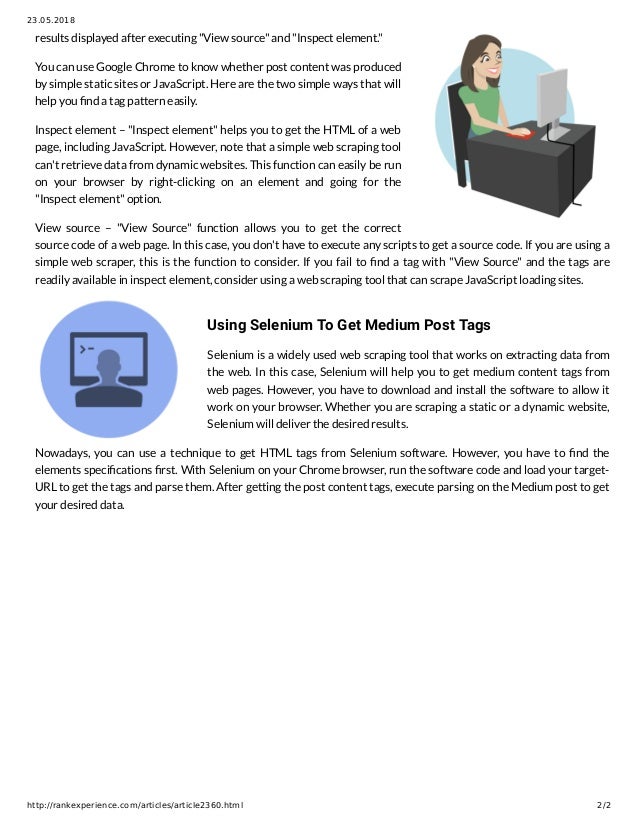For many of you, job backfill feeds are a familiar part of the job board and recruitment ecosystem. They supplement natively posted jobs on your board by providing automatically published jobs from across the jobosphere. Feeds enhance the job seeker experience, increasing the likelihood they find relevant opportunities and encouraging return visits.
For more insights into backfills and why they are worth considering, read our blogs posts on backfill feeds. Or here is a quick summary:
Introduction Web Scraping is a technique to extract the data from the web pages but in an automated way. A web scraping script can load and extract the data from multiple pages based on the requirements. Obtaining data manually from the browser is a tedious task, so it's better to do it in an automated manner.
- Advanced web scraping. Ask Question Asked 5 years, 9 months ago. Active 1 year, 3 months ago. Not for regular web scraping. Why not to use a special web scraping software? Most of them support logging in and complicated html and js-driven pages scrape. Seems to me your case is not a pure html page but a js-stuffed web page.
- Expert Team for Web Scraping We have built so many crawlers and after some point we wanted to offer our experience as a SaaS. You don’t need to find a suitable proxy service and build your own structure anymore. We have built an architecture that rotates every request and able to manage captcha handling as well.
What Are Backfill Feeds?

Backfill feeds work by collecting job posts, employer profiles, and sometimes even candidate data. Usually they are exported as XML or RSS feeds, but sometimes they require an API to function. These feeds can be set up in your Careerleaf board so that they automatically publish jobs directly into your board. For most niche job boards the challenge with backfill is relevance. Poor filtering controls and inventory gaps make these feeds at best inconsistent and, at worst, they can undermine the core value proposition of your site.
Let’s say your job board needs job content that fits both your niche and are limited to your geographical region. If a feed succeeds at one but fails at the other, it’s not the feed you need. Another common issue is that the keywords for your niche will likely bring in several to many inappropriate jobs for every one that is a good fit.
Poorly or inconsistently formatted job posts from feeds degrade the candidate experience and employer brands alike. Through custom job scraping, job board owners can eliminate these problems. Unlike standard feeds, custom job scraping can be as granular as you need it to be, targeting any data point and delivering highly specialised feeds in the format you need. Job scraping allows you to collect more and better data than ever before.
What Is Job Scraping?

Advanced Web Scraping In R
Job wrapping, employer feeds and job scraping are all synonyms for the same thing: collecting specific jobs data and publishing it in your job board.
Scraping is an automated process where data is fetched, or downloaded, from a target site. Web scraping is being used to power competitor research, market analysis, reading consumer sentiment, predictive analytics and fundamental data science. But even more important than volume of data, is how web scraping allows for greater specificity. Because a raw scrape can result in a huge volume of not very useful data, scraping bots are designed to target specific pieces of data, and return it in a specific format.
Web Scraping Service
Job scraping is remarkable for four reasons:
- Targeted web source – pick top employers, best job sources
- Customize retrieval of particular data points – capture logo, certification requirements or industry specific categories
- Opportunity for enrichment – additional data points, enhanced employer profiles
- Customized output – remove irrelevant data points, optimize feeds for your board and audience
Job scraping, unlike traditional feeds, can deliver the information you need, how you need it, and when you need it. For example, you could scrape all of the Austin-based graphic design jobs from your client base and automatically publish them in your board. If that net was still too broadly cast, you could have the feed adjusted to return only senior graphic design roles and add in more data points from employer profiles.
Advanced Web Scraping With Python
Careerleaf’s new jobs data scraping service has made it easier than ever for job board owners and recruiters to collect and publish customized feeds. You define your needs and we deliver feeds to fulfill them.

If you’re interested in working with Careerleaf to set up a scraping service, get in touch today!
Advanced Web Scraping Pic





